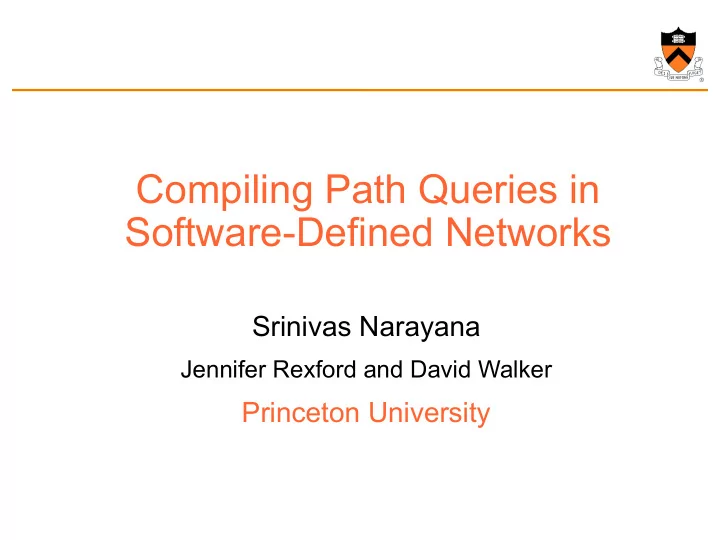

Compiling Path Queries in Software-Defined Networks Srinivas Narayana Jennifer Rexford and David Walker Princeton University
Where’s the packet loss? Faulty network device(s) along the way. But where? A B 100 pkts 25 pkts L 2
Where’s the packet loss? Solution idea: Check how far packets get from A to B before being dropped somewhere. A B 100 pkts 25 pkts L Fine-grained packet counters + Forwarding Complex policies 3
Where’s the packet loss? Instead: nice to get A à B packet counts each step along paths where A à B traffic flows 25 25 A B 50 25 100 25 0 50 50 100 pkts 25 pkts L 4
Wouldn’t it be nice to ask questions about packet paths in a network? Problem: we only observe a given packet independently at different switches. 5
We’ve designed a path query system that analyzes packet paths directly in the data plane. 6
Problem statement 1. Operator/application specifies network path queries 2. Translate into efficient and direct switch measurements (i.e., data plane rules) 7
Problem statement Independent specifications Query Query Forwarding Compiled into data plane rules 8
Solution architecture 1. Path query language Regular expressions of Query expressions Statistics packet location & headers 2. Query compiler and runtime SDN controller Payloads 9 Statistics
Path Query Language 10
Let’s write some queries! (1/3) • Count packets reaching switch S1 , then S2 with an internal source IP address (10.0/16) switch=S1 A hop on the wire ^ switch=S2, srcip=10.0/16 11
Let’s write some queries! (2/3) • Capture packets evading a firewall in the network ingress egress ingress egress ingress egress ingress() ^ 0 or more (switch != FW)* repetitions ^ egress() 12
Let’s write some queries! (3/3) • Switch-level traffic matrix: E1 E1 E2 E2 ... ... I1 I1 250 100 ... I2 I2 120 95 ... ... ... ... ... 13
Let’s write some queries! (3/3) • Switch-level traffic matrix: Flow Flow #pkts pkts ingress() * 1000 ^ Count all packets, going (true)* from any ingress to any egress. ^ egress() 14
Let’s write some queries! (3/3) • Switch-level traffic matrix: Flow Flow #pkts pkts groupby(ingress(), sw=I1, sw=E1 250 [switch]) sw=I1, sw=E2 100 ^ ... ... Group counts by (true)* packet’s ingress and egress switch! ^ è Traffic matrix! groupby(egress(), [switch]) 15
Let’s write some queries! • More example queries in the paper 16
The Runtime System 17
How to analyze packet paths in the data plane? 18
Packet paths on data plane • Main idea: Record path information in packets [{sw: S1 [{sw: S1, ...}, [{sw: S1, ...}, port: 1 {sw: S2 {sw: S2, ...}, srcmac: ... port: 3 {sw: S3 srcip: ... srcmac: ... port: 2 ...}] ...}] ...}] • As such, too much state! 19
Reducing path state on packets • Observation 1: Queries already tell us what’s needed! • Only record path state needed by queries • Observation 2: Queries are regular expressions • Regular expressions è Finite automaton (DFA) • Distinguish only paths corresponding to DFA states 20
Reducing path state on packets • Observation 1: Queries already tell us what’s needed! • Only record path state needed by queries Record only DFA state on packets (1-2 bytes) • Observation 2: Queries are regular expressions • Regular expressions è Finite automaton (DFA) • Distinguish only paths corresponding to DFA states Use existing “tag” fields (e.g., VLAN) 21
Example: Query Compilation (1/3) Query: (switch=S1, srcip=10.0.0.1) ^ (switch=S2, dstip=10.0.0.3) S1 S2 switch=S1, switch=S2, srcip=10.0.0.1 dstip=10.0.0.3 Q0 Q1 Q2 22
Example: Query Compilation (2/3) switch=S1, switch=S2, srcip=10.0.0.1 dstip=10.0.0.3 Q0 Q1 Q2 Switch Switch Match Match Action Action S1 state=Q0, srcip=10.0.0.1 state=Q1 DFA transition S2 state=Q1, dstip=10.0.0.3 state=Q2 S2 state=Q1, dstip=10.0.0.3 count DFA accept 23
Example: Query Compilation (3/3) DFA- Forwarding DFA- Transitioning Accepting All acting on the same data plane packets! Frenetic composition operators (details in paper) 24
Implementation • Prototype on the Pyretic (NSDI’13) SDN controller • Implementation publicly available online • http://frenetic-lang.org/pyretic/ • Evaluation: • Payload collection bandwidth • Rule space • See paper. 25
Summary DFA state can be used to track packet paths directly on the data plane. Measurement and forwarding can be specified independently. 26
Happy to answer queries ;) narayana@cs.princeton.edu 27
28
Recommend
More recommend